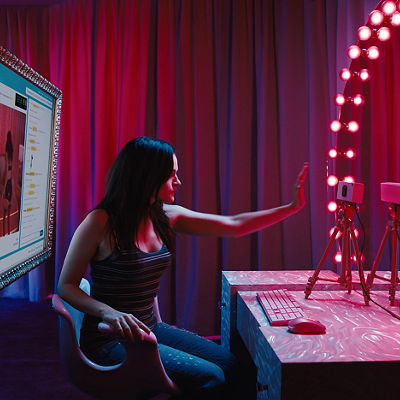The first film of his that I sat through, 1990's everybody-has-a-secret-twin movie, The Double Life of Veronique, felt so hermetically sealed off from anything recognizably real that it was like a parody of a foreign film. And until now, his acclaimed trilogy on France's national mottoes and colors also didn't do much for me. Blue, about a French composer's widow struggling to emerge from her shell and gain Liberte from her own grief, was an irritating figurine of a film, an existential cartoon for adults.
White was more fun, if only because Kieslowski infused his story of a Polish hairstylist's quest for Egalite with plenty of broad humor -- but it felt like a lighthearted concept shoehorned into a series fraught with larger meanings. You couldn't laugh long without the director throwing a symbol at you.
But Red, the trilogy's conclusion, is a masterwork. It's almost impossible to describe in detail because it's nonlinear in its storytelling style and dependent on mood, texture, camera placement, sound effects and almost invisible tricks of actorly performance to achieve its effects. Trying to capture its splendors on paper is like trying to recover the rush of feeling given you by a strange and exhilarating dream.
In following the lives, loves, fears and secrets of a small group of citizens living in Geneva, Switzerland, Kieslowski hits his audience with a sea of red objects and images, thereby taking care of the questions raised by his title, and he treats the national motto issue (Fraternite) so lightly that he seems to have jettisoned altogether the notion of linking the trilogy -- at least until the finale, which unites several of the trilogy's themes and characters with wit and invention to spare.
The central story of Red, if it can truly be said to have one, concerns a fashion model named Valentine (Irene Jacob) who accidentally hits a dog while driving home one night. She takes the wounded animal to its owner, but he's indifferent both to the animal's condition and to her guilt. His name is Joseph Kern, and the great French actor Jean-Louis Trintignant plays him as a strangely Kafkaesque figure whose silences express volumes of quiet angst.
Kern is a onetime judge who left the profession after a mysterious and unfortunate turn of events -- the jurist had to pass judgment on a man who was sleeping with Kern's own wife. Now the judge is a hermit, living in a gloomy old house and using a special radio to eavesdrop on the conversations of his neighbors. But refreshingly, the filmmaker isn't interested in explaining the judge to death. And he's equally uninterested in explaining why Valentine is drawn to the strange old man, and why they would build, over time, a strange and strong emotional bond.
Kieslowski respects mysteries -- the vagaries of the human heart, the buzz of human interaction that takes place as his characters wander about Geneva, passing through apartments, houses, buses, ferries, shopping malls, restaurants and other locations. (The film is a poem to city life as lively and brilliant and passionate as anything by William Carlos Williams; in sheer number of indescribably tactile splendors, it's the equal of Wings of Desire.) Plenty happens in the movie: Valentine has to come to terms with her relationship to her junkie brother and finds love with a man she was destined to meet -- at least according to the weird old judge. There are at least four or five other subplots unfurling simultaneously. What makes this film special is that words such as "plot" and "characterization" and "ending" and "theme" don't describe what's beautiful about it. You don't sit through Red to find out what happens next, but to feel what happens next.
It was first remarked many decades ago that in shackling itself to narrative storytelling, cinema stunted its growth as an art form -- that it should have moved immediately away from what novels and plays can do and become more like poetry and collage and music. But what's unfortunate is that all too often, filmmakers who try to break away from convention lack the precision and discipline required to pull their movies off. What they come up with are tantalizing fragments of a higher kind of filmmaking sandwiched between long stretches of pretension and silliness -- films that intentionally reject the crutch of a story yet ultimately prove incapable of standing alone.
But Red is one of the rare successes in this mode. There isn't a dull or uninteresting frame anywhere in it; every second makes you tingle and smile and gasp for reasons you can't put into words. It's like a symphony in 35 millimeter -- a rush of feelings and allusions and motifs that build and connect and pulse with life.
Watching it makes you feel as if you're watching hints of film's future. It's the cinematic equivalent of the monolith in 2001, appearing on our collective horizon to hint at where we're headed, who we might become and how transcendent movies could be if every filmmaker were as brilliant as Krzysztof Kieslowski.
-- Matt Zoller Seitz
Red
Directed by Krysztof Kieslowski. With Irene Jacob and Jean-Louis Trintignant.
Rated PG-13.
108 minutes.





